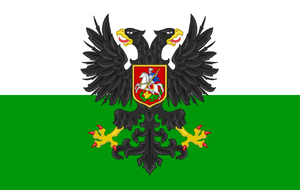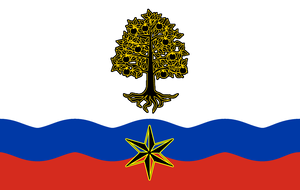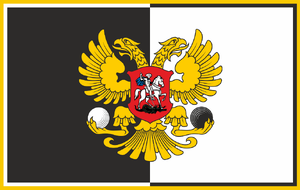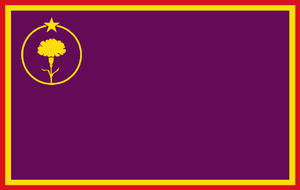Tomsk
Tomsk, officially the Central Siberian Republic, is a Russian warlord in central Siberia. It is bordered to the west by the Free Aviators, Sverdlovsk, Tyumen, and Omsk, to the south by Novosibirsk, Kemerovo and Krasnoyarsk, to the north by the Unorganized Siberian Territories; and the east by Siberian Black Army. The country is ruled by the conservative Decembrists, led by President Boris Pasternak.
History
The foundation of the Republic
As the Germans captured both Leningrad and Moscow in the late 1940s, many artists, scientists, academics and other literati fled the fascist advance, crossing the Ural Mountains. Eventually, they gathered in the city of Tomsk to establish the Central Siberian Republic as the USSR crumbled. Initially, this was an ordinary republic, whose political parties, although containing high proportions of these academics, were modelled after traditional parties in Western democracies. However, it was the presence of a highly cultured and educated elite that would eventually lead to the evolution of these political parties into the salons of Tomsk.
Once order had been restored to the region, these intellectuals would lead the people in creating the first democratic government since the short-lived Russian Republic of 1917: the Central Siberian Republic. At this time, sizeable portions of the population simply wanted a return to stability, and a continuation of Nikolai Bukharin's Soviet Government. Furthermore, generals such as Alexander Pokryshkin and Nikolai Andreev advocated for an indefinite military junta which would stabilise the region until Russia had been unified, at which point a democratic, civilian-led government could be restored. Such sentiments would sow the seeds for the eventual collapse of the Republic at the hands of secessionists. Nonetheless, the First Constitutional Congress of Central Siberia, held in Tomsk and chaired by Boris Pasternak, saw a vote in favour of establishing a liberal democratic constitution, enshrining freedoms and civil liberties that had been sorely missed under Nikolai Bukharin's rule.
Now that the political situation had stabilised, the first order of the day, under the newly elected Poet-President, Pasternak, was to secure the stability of the region. Fortunately, Central Siberia was the target of Nikolai Bukharin's interwar Siberian Plan, which had provided it the area with a sturdy industrial base, including considerably sized factory complexes that had escaped the devastation of the Great Patriotic War and the Luftwaffe. Pasternak's government immediately set about reactivating these complexes to meet both civilian and military needs.
This done, the government turned its attention to the food supply. The Barnaul region, governed by Vasily Shukshin, thus became the breadbasket of Central Siberia, producing abundant supplies of food that were distributed across the region in an attempt to bind the disparate loyalties of its inhabitants to the central government. At the same time, the government ramped up military production to arm its militias, which were united under the command of Marshal Matvey Shaposhnikov, a former Red Army commander who had been discharged after his refusal to order a tank division to fire upon a panicked train of civilians fleeing the Siege of Moscow. To do this, the Republic began recruiting people from its more populous settlements, such as Novosibirsk. However, the requisitioning of both food and men from this area intensified a low-level separatism that would soon burst into flames.
The Siberian War
The stability and prosperity brought about by the Republic's actions was not to last. The Far Eastern Soviet, composed of the remnants of the Soviet government that had been evacuated from Moscow under Genrikh Yagoda, had begun massing its armies on the border. Jealously eyeing the food supplies and factories of the Siberian Plan, Yagoda soon launched an invasion of the Central Siberian Republic to secure his own position in the East.
The southern thrust of this invasion was ordered to seize Abakan, and then turn north to Krasnoyarsk, with the goal of severing the rail connections to the frontlines in Bratsk and starving the Republican Army of supplies. The goal of the northern thrust was to smash through the Republican Army divisions at Bratsk and then push on to capture Kansk, after which the two armies would meet at Krasnoyarsk.
Although the southern force was repulsed by Republican troops relatively easily, the northern armies, which contained the bulk of Yagoda's veteran troops and hardened NKVD officers, fared much better. This northern army inflicted several defeats on the 3rd Republican Army under Nikolai Krylov and Nikolai Andreev, who were forced to slowly retreat in an agonising rearguard action. However, they managed to deal significant damage to the overextended northern Soviet spearhead, causing the two sides to settle into a siege at Kansk.
The Republic, hoping to take advantage of the failed southern Soviet offensive, commanded Alexander Pokryshkin's 2nd Army and Matvey Shaposhnikov's 1st Army to defeat the Soviet Armies there. Although they managed to win a significant victory at Novokuznetsk, where some of Yagoda's divisions were encircled and neutralised after a surprisingly quick battle, their progress was hindered by the rough terrain to the east of the Kuznetsk Basin.
Thus, neither the Central Siberian Republic nor the Far Eastern Soviet had managed to actually make any significant gains in the war. The conflict then began to degrade into a series of attacks and counter-attacks reminiscent of the Western Front in World War One, where one army would seize a strip of land at great cost, only to be driven back by the opposition, who also suffered significant casualties in doing so.
This situation forced the Republican government to begin intensifying conscription efforts and the requisitioning of food supplies. For Pokryshkin and Shukshin, this was the final straw, as riots began to break out in Novosibirsk and Barnaul. The Republic, panicking at this turn of events, decided to send in the army to end this revolt. However, this backfired, causing the two men to secede and form the Federation of Novosibirsk and Altay, ostensibly to protect the inhabitants of the region from further Republican 'tyranny'.
The outlook in the East was not any better. At around the same time, the offensives of the Anti-Bolshevik Front, originally based in Harbin, managed to capture a swathe of the Far East, from Chita to Magadan. This fortuitous happening managed to throw Yagoda's troops into disarray, causing their assault on Kansk to be repelled, albeit with heavy losses on both sides. However, this was followed by an uprising of anarchist rebels who seized the town of Bratsk, surprising the Soviets, who were now trapped between it and Kansk, by attacking their rear. Citing the devastation of their lands by both the Republic and the Soviet, the anarchists fought with a ferocity unseen on the battlefield, forcing the Soviets to withdraw south of Bratsk and then east. This done, the anarchists continued their offensives and drove Krylov and Andreev out of Kansk, establishing the Siberian Black Army.
The Republic then ordered Krylov and Andreev to retake Kansk; however, they were routed and forced to retreat to Krasnoyarsk, being forced to leave valuable artillery pieces on the eastern side of the Yenisei River, in the hands of the anarchists. A further attempt to retake these guns caused Andreev to mutiny and seize the city of Krasnoyarsk, forming a 'Provisional Government'. A desperate Krylov, now trapped between Andreev's rebels and the anarchists across the Yenisei, managed to smash through a weak spot in Andreev's defenses south of Krasnoyarsk. Regrouping at Kemerovo, Krylov seized the region and fell into depression, to later re-emerge as Rurik II.
The aftermath of the Siberian War
This string of defeats nearly caused the Republic to fall, and it may have been extinguished completely, if not for the intervention of Marshal Shaposhnikov, who managed to rally the remnants of the Republican Army around the core of the 1st Army. Under his command, the Army quickly secured Tomsk, peacefully defusing the protests simmering in the city and removing any disloyal elements who wished to place the region under military control.
At Shaposhnikov's suggestion, Pasternak held a hastily-organised referendum to establish an emergency provisional government, to stabilise the situation in the aftermath of the collapse of the Central Siberian Republic.
The current situation
Politics
As of 1962, Tomsk has maintained its emergency provisional government. although its main political parties have by now transformed into the Salons that define so much of the city's life. But Pasternak, crippled by the stresses of the Siberian War and the collapse of the Republic, and the cancer which has sapped at his vitality, knows that his time is approaching. He has determined that Tomsk must have elections, and a proper government, if it is to survive him.
Tomsk Duma interactions
Unique to Tomsk is its Duma, where each of the four Salons participate in debates and governance. Each salon has a list of interactions which can change their popularity and authority. To avoid repetition, the interactions will be set out to apply to all salons at once. All interactions have a cooldown of 30 days.
- The Decembrist White Duma is bicameral, where bills are drafted in the Lower House and passed in the Upper House.
- The Humanist Red Duma is composed of only a Lower House where bills are drafted and adopted as law.
- The Modernist Blue Duma is composed of 7 Cabinet Positions: The Ministers of Industry, Technology, Science, Infrastructure, Education, Commerce and Military.
- The Bastillard Grey Duma is reverse bicameral, where bills are drafted in the Upper House and passed in the Lower House.
| Ask for selected Salon Support in Lower House (not available to Modernists) |
|
| Ask for selected Salon Support in Upper House (not available to Humanists) |
Ruling Salon is Decembrists or Bastillards:
Ruling Salon is Modernists:
|
| Pro-selected Salon Campaign |
( Tomsk, Novosibirsk, Krasnoyarsk or Kemerovo):
|
| Anti-selected Salon Propaganda |
One of 3 options will happen.
|
| Consolidate selected Salon Rule |
|
| Weaken selected Salon Authority |
( (Tomsk, Novosibirsk, Krasnoyarsk or Kemerovo)):
One of 3 options will happen.
|
National spirits
| Formation of the Salons |
Tomsk's long tradition of academic research and artistic development has recently crystallized in a very unusual set of political organizations. Joining together socio-historical ideas and politico-economic theories with artistic ideals, the four great Salons of Tomsk are a dizzying combination of political parties, military cliques, avant-garde artists and social movements. While each Salon roughly approximates a traditional political current, none of them are likely to have twins in any other democracy of the world... |
| Warlord of the City |
The Central Siberian Republic has been critically wounded by traitors and separatists. Now Pasternak's great democratic project has been pushed to its last retrenchment, and many doubt the Republic will see the end of the sixties. All is not lost, however, for the remaining soldiers are determined, and led by the indefatigable Marshal Shaposhnikov. The Republic still lives, and its troops will face any opposition to save their homeland! |
| Provisional Government |
The successive disasters of separatism in Barnaul, war with Yagoda's accursed Soviet remnants and mutinies in the army have broken the back of the old Central Siberian Government. Now, an emergency provisional government led by Boris Pasternak tries to keep the Republic alive. While the population in Tomsk have been appreciative of the efforts of the Pasternak cabinet to fight these catastrophes, the haphazard provisional government is badly overextended. The state of emergency cannot go on forever. |
Flags
| Flags | |||
|---|---|---|---|
| Flag | Country Name | Ideologies | Notes |
| Central Siberian Republic | |||
| Central Siberian Republic Siberian Republic Republic of Russia |
Decembrist victory | ||
| Central Siberian Republic Siberian Republic Republic of Russia |
Bastillard victory | ||
| Central Siberian Republic Siberian Republic Republic of Russia |
Modernist victory | ||
| Commonwealth of Siberia Commonwealth of Russia |
Humanist victory or Siberian Black Army collapse | ||
Trivia
- One event will see the Bastillards create a radio serial by the name of "Welcome to Dolina Nochi", which is a reference to the podcast "Welcome to Night Vale" - while Dolina Nochi does not directly translate to Night Vale (it roughly translates to "Valley of the Night"), many of the events mentioned in the "Dolina Nochi" event are similar to those that happen in episode two of "Night Vale" (most notably a glowing cloud and dragon wanted for insurance fraud).
- Prior to the Toolbox Theory Update, Tomsk used to own North-Central Siberia; this territory now starts the game without an owner until Central Siberia is unified.
- Conservative states
- Countries
- Russian warlords





